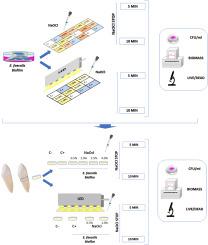Journal of Photochemistry and Photobiology B: Biology ( IF 5.4 ) Pub Date : 2020-08-08 , DOI: 10.1016/j.jphotobiol.2020.111989 Simonetta D'Ercole 1 , Paola Di Fermo 2 , Mara Di Giulio 2 , Silvia Di Lodovico 2 , Emanuela Di Campli 2 , Antonio Scarano 1 , Domenico Tripodi 1 , Luigina Cellini 2 , Morena Petrini 1

|
New strategies are necessary for the prevention of endodontic infections caused by Enterococcus faecalis, a common resistant pathogen and biofilm producer. Aim of the present study was to compare the effects of Near-Infrared (NIR) Light-Emitting Diode (LED) irradiation and different concentrations of sodium hypochlorite (NaOCl) alone or combined to each other on the E. faecalis biofilm, on artificial and human dentin surfaces.
E. faecalis ATCC 29212 preformed biofilms, on polystyrene wells and on dentin discs, were treated with 880 nm NIR irradiation and NaOCl at 4%, 2.5%, 1% and 0.5% alone and combined to each other (NIR irradiation plus NaOCl 1% or 0.5%) at 5 and 10 min. Treated biofilms were compared to the controls for (i) biofilm biomass evaluation, (ii) CFU count for the quantification of cultivable cells and (iii) cells viability.
All the detected experimental conditions displayed a significant reduction of biofilm biomass (p < 0.001) and CFUs/mL (p < 0.01) in respect to the controls on both tested surfaces. The effects on the E. faecalis biomass, colony count and cell viability were not time-dependent except for NaOCl 2.5% and 1% in the biofilm biomass reductions on human dentin discs. NIR-LED irradiation alone showed a reduction of E. faecalis aggregates without interfering with cell viability whereas NaOCl alone expressed a killing effect in a concentration dependent way. The combination of NIR-LED irradiation with NaOCl 1% and 0.5% displayed a double effect of cluster disaggregation and cell killing.
In particular, NIR-LED irradiation combined with NaOCl 0.5% displayed an anti-biofilm activity major than those expressed by NaOCl 0.5% alone (p = 0.001) with a reduction of biomass 93% vs 71% and 97% vs 25% after 10 min, on polystyrene wells and human dentin discs, respectively.
The innovative use of NIR-LED irradiation combined at short times with low concentration of NaOCl (1% and 0.5%) is capable to reach a significant effect on E. faecalis biofilm, especially on human dentin discs.
中文翻译:

近红外NIR辐射和次氯酸钠:在牙髓感染中抵消粪肠球菌生物膜的有效结合。
预防由粪便肠球菌引起的牙髓感染的新策略是必需的,粪肠球菌是一种常见的耐药病原体和生物膜生产者。本研究的目的是比较近红外(NIR)发光二极管(LED)辐射和不同浓度的次氯酸钠(NaOCl)单独或彼此结合对粪肠球菌生物膜,人工和人工粪便的影响。人类牙本质表面。
用880 nm NIR辐射和单独4%,2.5%,1%和0.5%的NaOCl处理聚苯乙烯井和牙本质盘上的粪肠球菌ATCC 29212生物膜,并将其彼此合并(NIR辐射加NaOCl 1%或0.5%)在5和10分钟。将处理过的生物膜与对照进行比较,以进行(i)生物膜生物量评估,(ii)CFU计数以量化可培养细胞和(iii)细胞活力。
相对于两个测试表面上的对照,所有检测到的实验条件均显示生物膜生物量显着降低(p <0.001)和CFUs / mL(p <0.01)。对粪肠球菌生物量,菌落数和细胞活力的影响不是时间依赖性的,除了人牙本质盘生物膜生物量减少的NaOCl为2.5%和1%。单独的NIR-LED辐照显示粪肠球菌聚集体的减少而不会干扰细胞活力,而单独的NaOC1则以浓度依赖性的方式表现出杀伤作用。NIR-LED辐射与NaOCl 1%和0.5%的组合显示出簇解聚和细胞杀伤的双重作用。
特别是,与0.5%NaOCl相比,NIR-LED辐照与0.5%NaOCl结合表现出的抗生物膜活性更强(p = 0.001),生物量减少10%后,分别为93%对71%和97%对25%分钟,分别在聚苯乙烯孔和人牙本质盘上。
NIR-LED辐射的创新应用是在短时间内与低浓度的NaOCl(分别为1%和0.5%)结合使用,能够对粪肠球菌生物膜,特别是对人类牙本质盘产生显着影响。


























 京公网安备 11010802027423号
京公网安备 11010802027423号